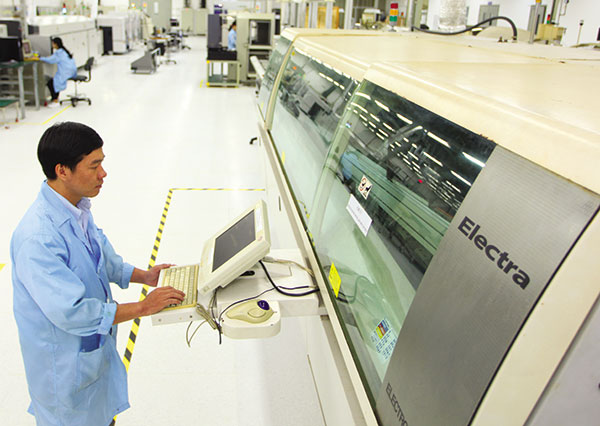Stock
commercial
- EXCHANGE
- GOLD RATIO
PE’s industrial moment may be here
12:00 | 20/09/2017
To sustain growth, Vietnam needs to build a strong industrial backbone with the help of foreign investments. Dr Per Stenius, client director at global professional services firm Reddal’s Seoul office, and Giao Le, business analyst at Reddal’s Helsinki office, discuss how private equity investors can seize opportunities in local industry.
Strong FDI but weak local industries
 |
In the last 15 years, foreign direct investment (FDI) in Vietnam has grown at 15 per cent every year, as multinational firms relocated their manufacturing bases to Vietnam to take advantage of low-cost labour and government incentives.
Vietnam’s growth can be largely attributed to export growth, with a significant impact from the FDI sector, accounting for 70 per cent of total exports.
However, heavy reliance on multinational firms for export growth is not sustainable for Vietnam. Foreign companies cannot serve as the backbone of an economy due to their mercenary nature – they are the first to move in favour of better conditions offered by countries elsewhere.
Consider the case of Malaysia, where the twin withdrawals of Seagate and Western Digital in 2016 from Penang to Thailand will result in thousands of jobs lost. At the same time, companies like Adidas are building highly-automated plants in the US and Germany to be closer to their customers, leveraging the latest technologies such as robotisation, cloud computing, and 3D printing to enable mass customisation at low costs. Such trends emphasise the need to prepare Vietnamese manufacturers to serve as the country’s industrial backbone.
The reality is that Vietnam’s export-led growth has not translated to strong local supporting industries. According to the Japan External Trade Organization, localisation rates of Japanese companies in Vietnam were 32 per cent, much lower than China (65 per cent), Thailand (56 per cent), and Indonesia (41 per cent). Excluding Japanese and Taiwanese suppliers operating in Vietnam, local companies accounted for less than 13 per cent of component purchases.
This is a missed opportunity for domestic manufacturers to benefit from foreign investments, because serving as suppliers to multinational corporations is one of the channels to absorb foreign technology, know-how, and management expertise spillover. Consequently, Vietnamese local supplier quality ranked 92 out of 144 countries in the OECD Global Competitiveness Report.
 |
| A key to PE investment in Vietnam is looking to create opportunities in non-apparent places Photo: Le Toan |
Bridging the gap
One lever to raise Vietnamese manufacturers’ capabilities is fostering linkages with the FDI sector, leveraging proximity to foreign know-how to accelerate the catch-up. The state can increase the spillover potential of multinational firms through investment and intellectual property policies, and boosting the absorptive capacity of local firms.
It is important to note that the government’s call for FDI and incentives for technology transfer without first improving local firms’ absorptive capacity will not help local industries. A key determinant of firms’ absorptive capacity is human resource quality and the technological state of the receiving firms. The closer the gap in such factors between foreign and local firms, the easier it is for local firms to absorb the spillover.
To close the gap, Vietnam should encourage research and development (R&D) activities in the private sector. According to the World Bank, Vietnam’s spending on R&D is low at 0.2 per cent of the GDP, compared to Malaysia’s 1 per cent and Korea’s 4 per cent, and is dominated by national institutions and state-owned enterprises.
Take South Korea as an example of the benefits that R&D can bring. The East Asian country has followed a successful technology-led growth strategy since the 1970s. In addition to funding R&D, the Korean government has actively shared publicly-funded R&D results with private firms, promoted R&D in private firms via tax incentives, and created public-private joint consortiums for larger and riskier projects.
Similarly, the Vietnamese government can boost the impacts of their limited R&D budget by sharing publicly-funded R&D outcomes to the private domain. Limited public funding means that the government should also incentivise and ease the path for private investors to invest in local manufacturers’ training and technology.
At the same time, early-stage education reforms are needed to focus on critical thinking, problem solving, teamwork, and communication skills, which are lacking in the current Vietnamese workforce. This gap was found to be more profound among innovative and exporting firms, reported a 2012 survey conducted by the World Bank and the Central Institute of Economic Management.
The role of private equity funds
Given the current situation, steering investment into the fragmented and cash-hungry local manufacturing sector can be a fresh alternative for private equity (PE) investors. This is especially true for new joiners.
Finding good deals in consumer-driven sectors has become increasingly difficult for Vietnam-based PE firms, as most lucrative targets have already been invested or grown into publicly-listed companies. Meanwhile, the valuations of available deals are inflated, driven by the premiums foreign companies are paying to secure a foothold in Vietnam.
Reddal’s interviews with leading PE firms in Vietnam revealed that deal scarcity and inflated prices have driven some funds to seek targets abroad or be less selective in choosing focus sectors. This is understandable but also unfortunate, as it does not speed up the development of capable Vietnamese industrial corporations and the small- and medium-sized enterprises (SMEs) supplying them.
Meanwhile, there is a good amount of room for value creation in the manufacturing sphere. As 93 per cent of manufacturers are SMEs, PE can utilise a roll-up strategy to boost deal sizes and improve efficiency through consolidation. Value creation opportunities also come from the proximity to foreign technologies and expertise thanks to the thriving FDI sector.
Admittedly, realising opportunities with local manufacturers has not been easy for PE firms. Mekong Capital’s first fund nearly 20 years ago targeted export-led manufacturing businesses but had to retreat, as they found local management skill and accounting transparency gaps too significant to overcome to achieve operational improvements. That is not to mention Vietnamese owners’ reported reluctance to equity financing, despite lack of finance being a common barrier.
However, the times are changing. Nowadays, PE may find family businesses in transition to second-generation management a suitable match. The second generation sent abroad to study is returning to take over the family business. Their international exposure and openness to change might be a key to opening this sector to PE by advocating organisational change toward professionalism and transparency. A similar trend has been seen in Korea, where SMEs increasingly contribute to industrial development as new owner-manager generations step in.
Tips for private investors
To succeed, PE firms need to balance between hiring local professionals to navigate a fragmented landscape with deep-routed managerial norms, and taking on expat PE veterans with solid portfolio management skills to push for the needed organisational transformation.
For instance, Mekong Capital only managed to turn around its investment in a manufacturing target after hiring a US expat to streamline its export division. The Mekong Capital case shed light on a conventional myth that hiring local people is key to succeeding in emerging markets like Vietnam.
Investing in local manufacturers’ capabilities is win-win for both the Vietnamese economy in the long run and investors looking for hidden yet attractive investment opportunities.
If done right, PE has the chance to play a much bigger role in the Vietnamese economy by steering value creation in the manufacturing sector. They may want to look out for mid-cap family businesses led by second-generation owner-managers eager to transform the legacy business into professional and growing ventures. Granted, there will be both cultural and capability hurdles, but those who succeed may see significant rewards from their hard efforts.
VIR










